| Botanical Name |
|
| Family |
Asclepiadaceae - The carrion or milkweed family. |
| Pronunciation |
|
| Common Name(s) |
|
| Plant Group |
- Ground Cover A plant with a low-growing, spreading habit, grown specifically to cover the ground.
- Succulent A plant having fleshy stems or leaves often adapted to dry conditions.
|
| Plant Size |
- Small
| Tree | 4m to 8m |
| Shrub | 50cm to 75cm |
| Perennial/ground cover | 10cm to 20cm |
| Bulb | 20cm to 30cm |
| Succulent | 10cm to 20cm |
|
| Position |
- Dry Shade Shady areas where soil has poor water retention or are dependent on rain for their moisture needs.
- Light or Dappled Shade Found below trees with sparse, open foliage. Ideal for the protection of herbaceous plants.
- Partial Shade The area is in shade for part of the day and in full sun for part of the day.
|
| General Information |
- Drought Tolerance: High The plant is well adapted to arid conditions; it can survive long periods of drought and high temperatures without extra water.
- Evergreen Plants that have leaves all year round.
- Frost: Tender A plant that will not survive any frost or low winter temperatures.
- Water Wise Plant species originating from low rainfall regions that require less water to survive and thrive than other plant species.
|
| Specific Information |
This family of plants are known as Carrion plants as their flowers have an odour of rotting meat. They are pollinated by flies attracted to the smell. In its natural habitat, plants of Orbea variegata are sheltered from the hot rays of the sun by the shade of thickets and shrubs, beneath which they make matted clumps. These plants prefer early morning or late afternoon sun.
This species is regarded as an alien invader in the southern parts of Australia .
|
| Ad Break |
|
| Flowers |
| Description |
flat, five pointed star with 'life-belt' ring around the centre
|
| Season |
|
| Colour |
|
| Growth Rate |
|
| Plant Uses |
- Border A strip of ground, at the edge of a driveway or path in which ornamental plants or shrubs are planted.
- Container Trees, shrubs and ornamental species that can adapt to growing in a restricted environment.
- Edging A low growing plant that provides softness or definition to the edges of a bed or walkway.
- Filler Either a fast growing tree or shrub used temporarily to fill in an area while the permanent plants grow to a desired size, or a plant used to fill gaps in borders or beds.
- Ground Cover Low-lying plants that spread fast, require minimal maintenance, and cover large expanses or bare areas between bulbs or shrubs. They provide protection from erosion and drought and improve the visual appearance of the garden.
- Interplanting Arranging and planting plants in the garden that have different blooming times and habits of growth, extending the amount of time in which the area is in flower.
- Pot Plant A plant that needs a protected environment on a patio or indoors.
- Stabilize Banks Plant is used to prevent soil erosion because their roots will form a mat that stabilizes the soil and keeps it from washing away in heavy rains.
- Wild Garden An indigenous garden planted for the benefit of wildlife and birds. Provides food, water, a variety of mini-biomes and no poisonous chemicals are used.
|
| Distribution and Habitat |
winter rainfall area of the Western Cape, mainly along the coastal belt, in the shade of shrubs
|
| Planting Suggestions |
Water sparingly, allowing the soil dry out between waterings and feed the plants during the active growing seasons of winter and spring. Soil should to be well drained and rich in organic matter. Most species prefer a well-drained, sandy medium consisting of equal parts of washed river sand, potting soil and topsoil. As this plant comes from a winter rainfall area, it should be given a rest period with reduced watering during the summer months. Try to emulate its natural habitat, placing it so that it is protected from the sun during the hottest part of the day.
|
| Medicinal Uses |
|
| Ad Break |
|


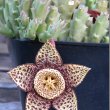
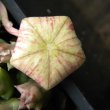
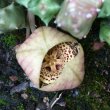
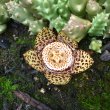
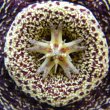
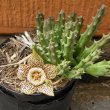
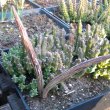
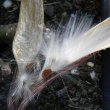


Comments
Aasblom = Basblom?
Dis seker die mooiste blom wat ek nog gesien het. Wanneer jy mooi naby kyk lyk dit asof dit 'n geborduurde blom is.
Myne het so pas weer begin blom. Dit is asemrowend mooi
Blom
Hier is die mooiste blom ooit
Orbea variegata flowers
Groete Marietjie
Dankie vir die mooi prent en ek stem saam. Dit is 'n pragtige blom. Jammer net dat dit jou asem sal roof as jou neus te naby kom!
Ek het bo nog fotos opgelaai.
Vriendlike groete
Lorraine
Basblom
Lorraine, Ek verkies om dit liewer Basblom as aasblom te noem. Ek moet sê ek het nog nie 'n reuk by dit bespeur nie. Daar vlieg ook nie brommers of vlieë nie. Dit is in my waskamer by die venster. My seun het eendag gesê wanneer blomme deur motte en nie vlieë bestuif word nie dan stink dit nie. Of dit waar is weet ek nie ek wil ook nie my neus teenaan druk nie. Wanneer dit vergroot deur in te zoom dan lyk dit soos 'n stuk borduurwerk of dalk boombas. Dankie vir die terugvoer. Ek het ook met hierdie - dis nou die tweede blom - dit stapsgewys afgeneem. Dit het amper gevoel soos 'n kuikentjie wat pik en uit die dop moet kom.
Basblom
Dag Marietjie
Ek weet ook nie of wat jou seun se is waar of nie en ek het nog nie informasie op die web of in my boeke hieroor gevind nie. Wat ek definitief weet is dat die meeste insekte, ek veral motte en kewers, net spesifieke gasheer plante besoek. Al die publikasies oor die Stapelia groep plante bewys dat hulle net deur vliee besoek word. Onder het ek 'n photo wat bewys hoever die vliee gevop is deur die reuk van die blomme. Die reuk is so naby aan verotte vleis dat, soos op die blom op die regte kant, hulle hulle eiers daarop le. Ek vind hierdie plante geweldig interessant en wil graag nog soorte van hulle versamel.
Aanpassings van Stapelia
Watter aanpasings het die plant om in sy omgewing voortekom?
Adaptations of Stapelias to survive arid situations
Hi Brenda
Verskoon dat ek jou vraag in Engels beantwoord.
Stems: thick and juicy - store water for use when water is scarce. Stems are covered with velvety hairs that help to prevent water loss. Leaves have reduced to tiny, papery bits on the tips of the spikes, reducing water loss. The stems do the photosynthesis. Stems are green during the growing period but become brown to purplish when there is little water. The brown patches protect the leaves from harsh sunlight and prevent drying out.
Roots: The plant branches out at ground level and the stems root shallowly where they touch the ground allowing the plant to take up more water during a brief shower.
Flowers and pollination: There are not that many pollinating insects in the arid areas where stapelias live so the plants have adapted their flowers to attract flies. The flowers smell like a rotting carcass, the purple-brown and yellow colours of the flowers give the impression of exposed flesh and the hairs on the petals add to the resemblance of a dead animal. The flower thus fools flies into thinking it is a rotten carcass and the fly pollinates the flowers when it lands looking for a meal.
Seeds: Seeds are attached to a tuft of hairs. Arid areas are often windy, to the seeds are adapted to wind dispersal.
Ek is amper seker dat hierdie 'n vraag vir skool is. As dit is, hoop ek dat jy goeie punte kry want jy het jou iniatief gebruik.
Vriendelike groete
Lorraine
Discuss this plant
Share knowledge, ask a question or give an experience.